When it comes to outfitting your kitchen with high-quality cookware that will last for years, Fissler and Le Creuset are two of the top brands to consider. Both companies produce professional-grade pots and pans designed for serious home cooks, but they have some notable differences.
This comprehensive guide examines the pros and cons of Fissler and Le Creuset cookware to help you decide which is best for your cooking needs and budget.
A Brief Comparison Table
| Category | Fissler | Le Creuset |
| Materials | Stainless steel, aluminum core | Enameled cast iron |
| Construction | Clad | Solid cast iron |
| Stovetop Performance | Excellent even heating | Good heat retention |
| Oven Performance | Good up to ~500°F | Excellent, thrives at high temps |
| Design Aesthetic | Modern, minimalist | Traditional, ornate |
| Handles and Lids | Ergonomic grip | Heavy, can get hot |
| Ease of Care | Dishwasher safe, easy | Hand wash recommended |
| Induction Compatible | Yes | No |
| Warranty | Lifetime limited | Lifetime limited |
| Best For | All-purpose cooking | Braising, oven dishes |
Overview of Fissler Cookware
Founded in 1845 and headquartered in Germany, Fissler is renowned for its innovative cookware technology and precision German engineering. Their pans feature patented features like the Fissler Crispy Element Technology (CTE) and Shape Efficiency Technology (SET) that deliver optimized cooking performance.
Some of the key features and benefits of Fissler cookware include:
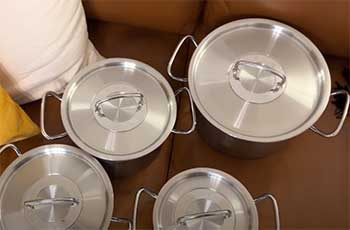
- Durable Materials – Fissler pans are crafted using 18/10 stainless steel with an aluminum core for excellent heat distribution. This makes them induction compatible. Many lines have non-stick ceramic-titanium coatings that are PFOA free.
- Ergonomic Designs – Fissler pan handles are shaped for balance and leverage. Lids fit precisely for better heat retention. Some models have helper handles and pour spouts.
- High Heat Tolerance – Their stainless steel construction means Fissler pans can safely handle very high stove temperatures. Lids stay on securely.
- Versatile Cooking – Suitable for all cooktops including induction. Oven and broiler safe up to 500°F. Freezer safe.
- Easy Maintenance – Fissler cookware is generally dishwasher safe. Stainless steel cleans up easily. Non-stick coatings reduce food sticking.
- Excellent Warranty – Lifetime limited warranty protects against defects. Does not cover normal wear and tear.
- Reasonable Pricing – Mid-range pricing from $100-$400 makes Fissler accessible for serious home cooks. More affordable than equivalent Le Creuset.
Popular Fissler product lines include Original Pro, Crispy Steelux, Adamant, and Edition.
Overview of Le Creuset Cookware
Based in France and founded in 1925, Le Creuset is famous for its colorful enameled cast iron Dutch ovens and skillets. Their cookware is hand-crafted using proprietary foundry techniques.
Some of the key benefits of Le Creuset pans include:
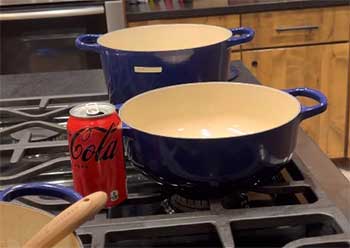
- Superior Heat Retention – The enameled cast iron construction retains and distributes heat evenly to prevent hot spots. Excellent for braising, simmering, roasting.
- Beautiful Enamel Exteriors – Available in a rainbow of vivid porcelain enamel finishes. Resists chipping and cracking.
- Cast Iron Durability – Heirloom quality build will last decades with proper care. Develops natural patina over time.
- Oven and Broiler Safe – Can withstand very high oven temps up to 500°F. Safe to use under the broiler.
- Easy to Clean – Smooth enamel is simple to hand wash. Most not dishwasher safe due to high heat damage risk.
- Lifetime Warranty – One of the best warranties protects against defects. Does not cover chipping or staining.
- Premium Price Points – $200 to $500 price range. Significant investment but pans will last a lifetime.
Well-known Le Creuset collections include their Signature, Classic, Heritage, and Toughened Nonstick lines.
Key Differences Between Fissler And Le Creuset Cookware
Now that we’ve covered the basics about each brand, let’s do a detailed comparison of their biggest differences.
Construction and Materials
The different materials used by Fissler and Le Creuset have major impacts on the durability, heating properties, care and maintenance, and pricing of their cookware.
Fissler uses stainless steel for most of its pans. The addition of aluminum cores enhances heat conductivity. Higher-end Fissler lines add ceramic-titanium reinforced non-stick coatings.
- The stainless steel construction makes Fissler pans induction compatible and allows for higher maximum heat levels. Stainless steel is extremely durable, stain resistant, and easy to care for.
- The aluminum core delivers quick, even heating across pan surfaces. It’s also lighter in weight than many materials.
- Fissler’s ceramic-titanium non-stick coating is PFOA free and designed to last significantly longer than standard Teflon coatings. It allows for low fat cooking and easy food release.
In contrast, Le Creuset uses enameled cast iron for most of their signature cookware. The enamel is glass-based and applied in multiple layers before firing at 1500°F.
- Cast iron offers unmatched heat retention and distribution. The weight also gives a stability perfect for searing and simmering.
- The glossy enamel resists staining and cracking. It’s impervious to acid and alkali damage. Easy to clean and colorful.
- Together the cast iron and enamel make Le Creuset Dutch ovens ideal for braising, roasting, baking, and more. Excellent oven and broiler safety.
The materials influence price as well. Le Creuset’s handcrafted enameled cast iron is inherently more expensive than mass produced stainless steel.
For induction compatibility, light weight, and budget, Fissler wins. But for traditional cooking performance and heirloom appeal, Le Creuset is hard to beat.
Design and Ergonomics
The designs and ergonomic profiles of Fissler and Le Creuset cookware also show distinct differences.
Fissler pots and pans have a more contemporary, minimalist look with their straight sides and sleek stainless steel finish.
- The streamlined aesthetic matches a modern kitchen decor nicely. Easy to coordinate across their collections.
- Their cookware is designed with ergonomic considerations like angled handles for easier lifting and control when cooking.
- Lids are precisiely fitted to lock in heat and moisture. Some lines include helper handles and pour spouts.
Le Creuset has a distinctly old-world artisan appearance with gently curved sides and colorful enamel finishes.
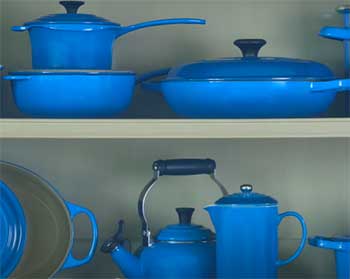
- Each piece feels hand-crafted and unique. The curving lines and deep hues are reminiscent of French country style.
- Less emphasis on ergonomic handles and lids. The emphasis is more on traditional functionality and visual appeal.
- Much heavier than Fissler cookware due to the hefty cast iron and enamel layers. Requires two hands to lift when full.
So Fissler wins for modern utility while Le Creuset provides traditional charm.
It’s a matter of personal style preference and ergonomic needs.
Performance and Cooking Abilities
Let’s move on to the all-important cooking performance abilities of Fissler and Le Creuset cookware.
Fissler’s stainless steel and aluminum core deliver quick, even heating across the pan surfaces.
- Excellent heat conduction for searing meats and vegetables. Low risk of scorching or hot spots.
- Suitable for all cooktops including induction and halogen. Oven safe to around 500°F.
- Non-stick versions allow for low fat cooking with minimal oil or butter. Easy food release when sautéing.
- High sides on pots help prevent boilovers. Tight-fitting lids seal in moisture and nutrients.
- Handles stay cool on stovetops. Helper handles and pour spouts on some pots add control.
Le Creuset’s enameled cast iron offers unmatched heat distribution and moisture retention.
- Once heated, the cast iron maintains temperature beautifully for low, even cooking.
- The heavy, tight-fitting lid holds in steam and heat for perfect braises and stews.
- Excellent for longer oven recipes like roasting meats or baking bread. Handles get hot!
- Enamel interior needs some seasoning but allows great browning during searing or stir frying.
- Slow to heat up and cool down due to material thickness. Requires some learning curve.
For quick stove cooking, Fissler may be preferable. But for oven dishes and one-pot meals, Le Creuset rules.
Ease of Use and Care
Day-to-day use and care are important considerations for cookware. Let’s see how Fissler and Le Creuset compare.
Fissler stainless steel cookware is quite easy to use and maintain:
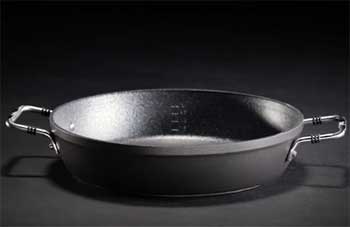
- Metal utensil safe including induction-suitable options.
- Mostly dishwasher safe for quick cleanup. Hand washing also easy.
- Durable stainless steel stands up to heavy daily usage with minimal wear and tear over time.
- Non-stick coatings reduce need for extensive scrubbing when food sticks.
Le Creuset enameled cast iron requires a bit more care:
- Hand washing recommended to protect delicate enamel finishes from dishwasher damage.
- Chipping and staining of enamel interiors can occur if overheated or knocked with metal utensils.
- Enamel hand-washing takes more time than stainless steel. Barkeepers Friend cleanser helps.
- Exterior enamel is durable but can chip if consistently dropped or knocked around.
For busy home cooks who want low maintenance and dishwasher convenience, Fissler is likely the better choice.
Cost and Warranty Considerations
With their premium materials and construction, both Fissler and Le Creuset sit at higher price points than entry-level cookware. Let’s examine their cost and warranty ranges.
Fissler price ranges by product line:
- Original Pro: $100 to $200
- Crispy Steelux: $200 to $400
- Edition: $300 to $500
- Adamant: $400 to $600
- Lifetime limited warranty against defects. Not against wear and tear.
Le Creuset price ranges by Dutch oven size:
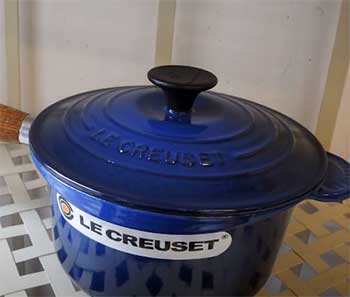
- 1.5 Qt: $200 to $250
- 5.5 Qt: $320 to $420
- 7.25 Qt: $370 to $500
- 13.25 Qt: $590 to $700
- Lifetime limited warranty against defects. Not wear, chips, stains.
For serious home cooking, both brands represent worthwhile investments.
Fissler gives you professional functionality at a more affordable price point for most families.
Le Creuset costs significantly more but will literally last generations with proper care.
Fissler And Le Creuset: Frequently Asked Questions
Both Fissler and Le Creuset represent top tier professional-grade cookware quality. High end Fissler lines like Original Pro, Edition, and Adamant compete with Le Creuset’s Signature and Classic collections for the absolute highest quality construction and cooking performance.
This depends on your cooking needs:
1. Stainless steel like Fissler’s is better for quick cooking and temperature control. Easy to care for and induction compatible.
2. Enamel like Le Creuset’s offers unparalleled braising ability. Beautiful colors but requires more careful handling.
For all purpose cooking, stainless steel may be more versatile. But for Dutch oven cooking, enamel can’t be beat.
Yes, Fissler cookware is excellent for induction ranges since it uses a magnetic stainless steel base. Lines like Original Pro, Crispy Steelux, and Adamant work beautifully on induction. Always double check for the induction symbol.
Le Creuset pans are excellent if you value traditional low and slow braising and oven cooking. Their enameled cast iron Dutch ovens offer superior heat retention and moisture sealing. High quality construction and iconic styling also make them great heirloom pieces. Avoid metal utensils to prevent enamel chipping.
Closing Remarks: Which Should You Choose?
Now that we’ve examined all the key differences, which brand is right for you? Here are some guidelines:
- For induction cooking or lightweight cookware, choose Fissler. Their stainless steel and aluminum construction is tailored beautifully to modern induction ranges. Their ergonomic designs make Fissler pans easy to maneuver.
- For traditional braises and oven dishes, go with Le Creuset. You can’t beat enameled cast iron for low, even cooking. Le Creuset Dutch ovens are heirloom pieces perfect for stews, breads, roasting, and more.
- For non-stick cooking, evaluate Fissler’s Steelux line. Their PFOA-free ceramic-titanium coating is durable and allows for low fat cooking. Le Creuset enameled cast iron relies more on seasoning.
- For casual cooks or budget-focused choices, lean towards Fissler. You’ll get high performance and quality that can still be passed down over generations. Le Creuset costs significantly more.
- For aesthetics and gifting, choose Le Creuset. The beautiful colors and elegant designs give Le Creuset cookware so much appeal. They make wonderful gifts and family heirlooms.
- Do you need both? Consider a Fissler frying pan and Le Creuset Dutch oven. This gives you the stainless steel performance and non-stick of Fissler along with Le Creuset’s cast iron braising mastery.
The bottom line?
For contemporary kitchens and cooks who value utility, Fissler wins out. But for old world cooking traditions and beauty, Le Creuset can’t be matched. With care and proper use, both brands will serve any home chef beautifully for decades on end.

